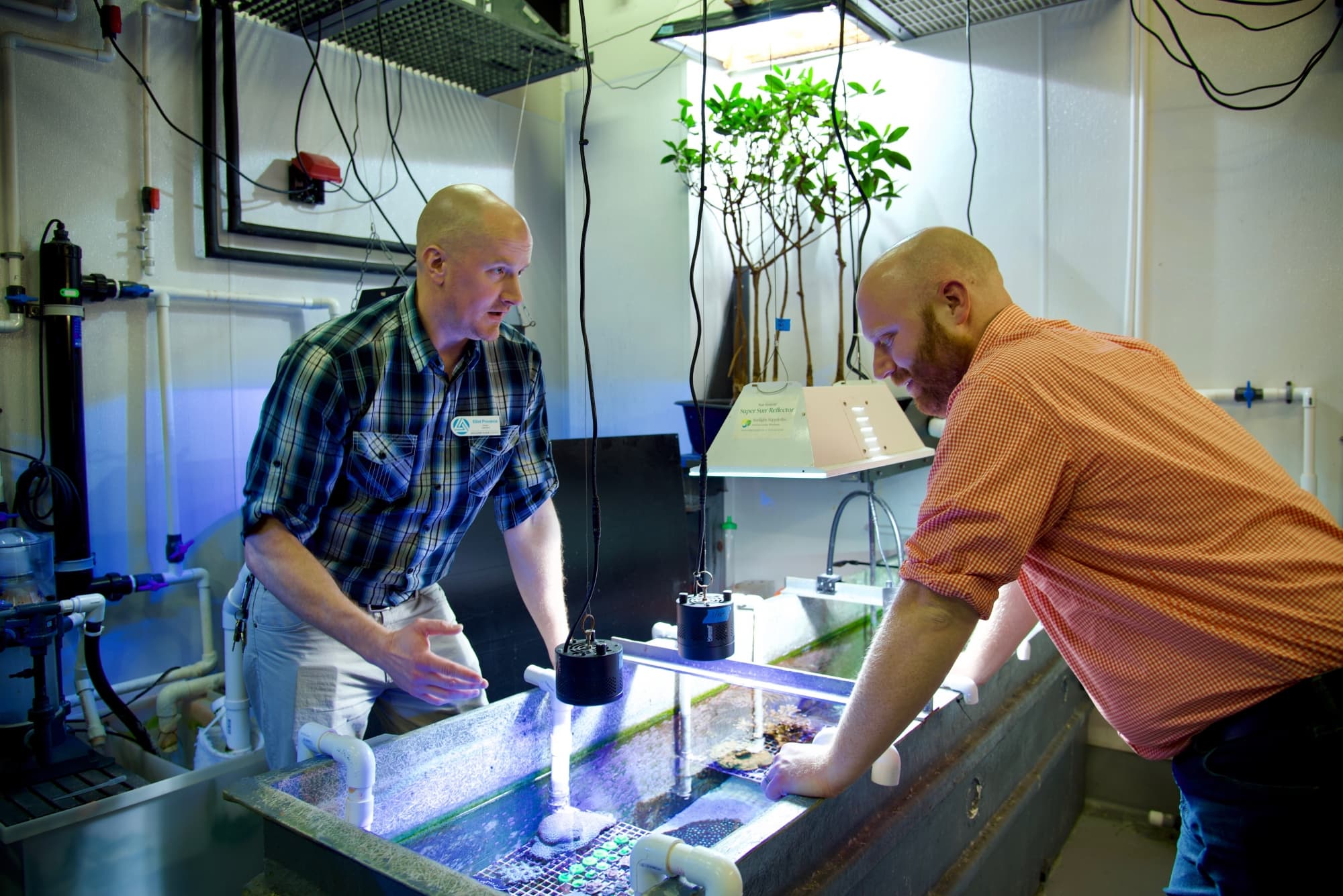Discovery Place, University: Symbiotic Partnership
By Lynn Roberson

Discovery Place aquarist Matt Lowder, a UNC Charlotte alumnus, participates in research trips to the Caribbean that involve University faculty and students.
Hermit crabs lumber across rocks covering the floors of saltwater tanks tucked behind the scenes at Discovery Place Science’s aquarium in uptown Charlotte.
As they move, the crabs carry anemones planted on their shells. Wherever the crabs go, they bring the anemones with them.
Both of these marine animals benefit from their symbiotic relationship. Venom in the anemones’ stinging nematocysts in their tentacles safeguards the crabs from being gobbled up by octopuses in their natural habitat. Meanwhile, the anemones take advantage of the locomotion the crabs provide, gaining access to more food sources than if they were stationary.
Researchers at UNC Charlotte are collaborating with Discovery Place scientists to gain more insights into these and other marine animals. And, like the hermit crabs and anemones, the collaborators benefit from a symbiotic partnership.
“There’s an interesting overlap between aquarists and scientists,” said Elliot Provance (’03), director of living collections and exhibitions at Discovery Place. Provance earned a bachelor’s degree in biology with an emphasis in ecology from UNC Charlotte and champions the collaboration.
Research in Landlocked City
“Aquarists have this talent of making sure that an organism or group of organisms are maintained in captivity, and this makes that resource available to scientists who might be doing research on the animal,” Provance said. “In a city like Charlotte, we’re a landlocked city, so having marine invertebrates in Charlotte is a valuable resource for researchers in the area.”
With more than 1,200 living animals at the museum, Provance is in charge of maintaining ethical and philosophical animal-care practices for an array of fish, birds, reptiles and arachnids.
Most recently, Discovery Place is working with researchers from marine biologist Adam Reitzel’s lab. Specifically, the team — including undergraduate and graduate students — is studying cnidarians, or sea anemones, corals and jellyfish. Discovery Place has acquired specimens to assist in the researchers’ work.
“Cnidarians can give us insight into how cells function, how metabolic pathways work, how symbiosis evolves,” said evolutionary biologist Jason Macrander, who is a postdoctoral fellow in Reitzel’s lab. Macrander studies venomous animals to probe questions on venom evolution, protein function and the physiology of symbiosis, with the potential for pharmaceutical and biomedical advances.
The broad implications for understanding how evolutionary and ecological factors influence biological interactions and molecular diversity of a species or group of organisms are compelling to the researchers.
“It helps us understand what’s happening at the genomic level, and that can relate back to what’s happening with snakes or cone snails or scorpions or other things,” Macrander said. “We have this box of what we know, and we think everything fits in this box. But then we come to Cnidaria — things are way outside of the box. So we’re trying to understand if we need to get a new box or just make the box bigger.”

Discovery Place’s Elliot Provance, left and Jason Macrander, a postdoctoral fellow in the Reitzel Lab, are collaborating on a marine research project.
Eyeing Biomedical Models
In addition to working with The Reitzel Lab, Provance has collaborated with UNC Charlotte biologist Amy Ringwood. Ringwood’s primary research interest involves understanding the cellular and physiological effects of environmental toxins on estuarine and marine invertebrates, and developing these systems as biomedical models for understanding the effects of toxins on basic cellular processes.
Ringwood has joined Provance, aquarist Matt Lowder, who is also a UNC Charlotte alumnus, and other Discovery Place staff on research trips to the Caribbean island of Curacao. There, scientists from around the world study the sexual reproduction of coral species and experiment on new ways to restore coral. They work under the guidance of SECORE, whose name derives from “SExual COral REproduction,” and is a global network focused on coral reef conservation.
For Discovery Place, forming a symbiotic relationship with researchers at UNC Charlotte aligns with its mission to inspire curious thinkers to discover the wonders of science, technology and nature. It also lines up with the museum’s focus on conservation.
“The most important overlap we have is outreach,” Provance said. “It’s a way for the work that UNC Charlotte researchers are doing to reach the public. We see three quarters of a million people every year on average here at Discovery Place. And when those people come through our doors, they will be able to see the conservation work we’re doing and the research on which we’re collaborating.
“While the research currently goes on behind the scenes,” he added, “the intent is to bring some of the species out onto the exhibit floor with information about the research, so that people can see and learn from it.”
Reitzel sees aspects of the partnership in a similar fashion and expects the collaboration to grow and impact a broad segment of the community.
“I think what we’ll see with Discovery Place is that by reaching out into the community and bringing in science that’s happening right now and sharing that interaction, we will help make science seem more real,” Reitzel said. “Science is not just a book of facts. It’s a practice that real people do.”
Lynn Roberson is director of communications for the College of Liberal Arts & Sciences. This article was previously published in UNC Charlotte Magazine’s Spring 2018 edition.